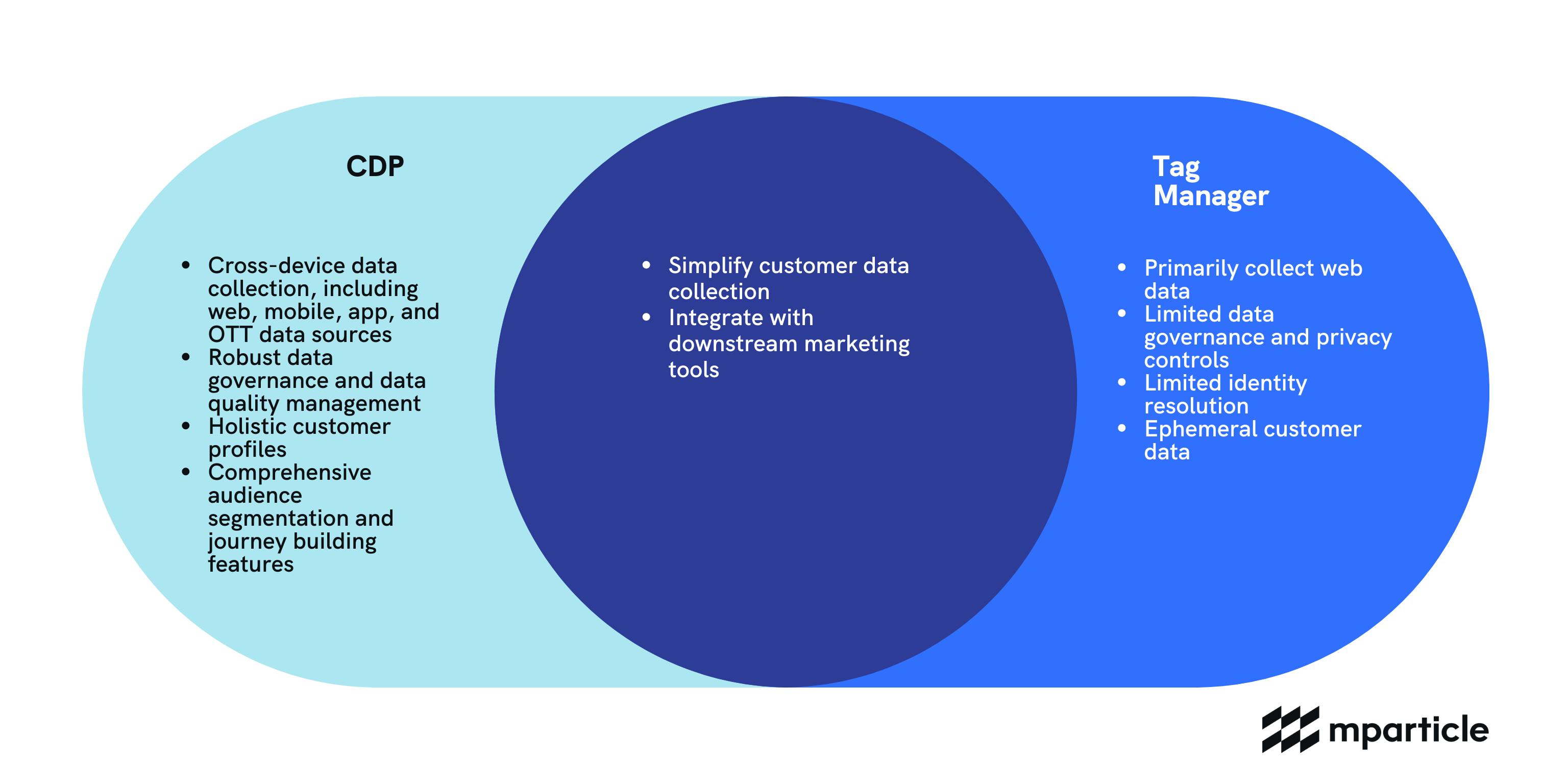Tag managers vs CDPs: What’s the difference?
Both tag managers and CDPs help marketers collect customer data without relying on engineering, but that's where the similarity ends.

In the world of marketing today, customer data is a superpower—if you can effectively pull insights from it and activate what you learn, that is. And there’s no shortage of tools available to help marketing and other teams wield customer data.
Tag managers are one such tool many of the marketers we work with have used in the past. They’re designed to help collect customer and event data and make it available to marketers—without the need for technical resources or developer bandwidth.
But as consumers have increasingly charted cross-channel, multi-device journeys, tag managers have developed a blindspot around mobile, OTT, and other customer touchpoints. That blindspot, along with growing needs for data governance and privacy controls, have led marketers to search for more comprehensive solutions.
That’s where Customer Data Platforms (CDPs) can help—they offer a single platform from which marketers can manage all customer data, from all sources, with solutions for identity resolution, data governance, activation, and more.
That search often leads marketers to wonder: How are CDPs different from tag managers?
This article will help you better understand tag managers vs. CPDs, including:
- What a tag manager is, and what it isn’t
- The gaps and limitations of tag managers
- How a good CDP can fill those gaps and more
What is a tag manager?
As mentioned, tag managers are designed to collect customer event data for brands so that marketing, finance, and operations teams can make data-driven decisions without using valuable engineering hours.
Tag managers rely on tags, or pixels, which are snippets of JS code embedded into web and mobile sites. Tags perform specific tasks, like displaying product recommendations or firing chatbot experiences, while collecting behavioral data on each customer. The most basic of tag managers help marketers deploy, edit, and remove tags while more advanced tag managers include more granular data management.
Besides this automation, tag managers provide robust integrations to adtech and analytics services, so brands are able to better track their data and use it to influence advertising strategy.
Because tag managers rely on tags fired as a result of customer actions, they can also provide limited identity resolution and data mapping onto users from on- and offline data. This is limited, however, by the source of the customer data—mobile, for example, tends to be hit or miss because tag managers use web-first tags, which:
- Don’t account for mobile-specific interactions like push tokens
- Only work on mobile web browsers, not apps
What a tag manager isn't
For all the benefits tag managers have been able to provide to marketers for the past decade, they can’t seem to keep up with modern data demands (like identity resolution, for example).
Tags are designed to be web-based and ephemeral. As consumers have shifted toward relying on their mobile devices to browse and shop—Statista estimates mobile commerce accounted for nearly 73% of retail ecommerce sales in 2021—brands have found that many of these devices don’t accept web-first tags.
Without access to mobile user data, brands are left making decisions and powering experiences based on a piecemeal view of the customer journey.
Tags also have an expiration date, meaning that customer histories and preferences aren’t available to brands long-term. This makes it difficult or impossible to convert one-off customers into loyal, high-value customers and run annual promotions.
Because tag managers rely on tags fired as a result of customer actions, they can provide only limited identity resolution and data mapping onto users from on- and offline data. This is limited even further when mobile, app and other customer touchpoints are missing.

What can't a tag manager do (and how can a Customer Data Platform help)?
Tag managers have their place in the marketing toolkit, but there’s also a lot they can’t help with—that’s where a CDP can add a ton of value to your customer data stack.
CDPs provide marketers with a single platform from which to manage all of their customer data, regardless of the source. Marketers can rely on CDPs to streamline data collection from mobile apps, websites, and other customer touchpoints, ensure data quality and identity resolution, enable rigorous data governance and security, build and share comprehensive audience segments, and integrate and activate customer data in real-time.
Granular, cross-platform data collection
As customers interact with brands across multiple channels and devices, they frequently change emails, share devices, log in and out, and delete apps and cookies. Tag managers only collect web data (not mobile or OTT, for example) and track broad, high-level traits like `pet_lover`. They aren’t, therefore, equipped to handle customer data from the entire, cross-platform customer journey and manage changes in identity state across platforms.
CDPs, on the other hand, are designed to collect and match data across multiple sources and create a unified, 360-degree view of the customer.
Through SDKs and pre-packaged API connections, they can ingest first-party data from anywhere your customers interact with your brand, including web, mobile, and OTT channels. They collect customer data right down to the individual level and include much more granular data points—like specific product impressions, color customizations, and more.
Data quality protection and identity resolution
For marketers, winning across digital channels depends on two things:
- How quickly you can react to customer actions and anticipate their needs
- The quality of the data you base those reactions on
The key lies in properly deploying your tracking plan and debugging as needed in real-time. Tag managers don’t have a way to solve for deduping or debugging at scale or in real-time, which often means you end up searching through multiple tools to find the problem and waiting around for event batches to process.
Capable CDPs offer a toolset for dealing with data quality issues. mParticle’s Live Stream, for example, automatically surfaces data quality errors where the data coming in doesn’t line up with your tracking plan. This is helpful for quickly diagnosing—and fixing—bugs in real time.
The data quality factor relies on more than just accurate, de-duped data—marketers also need timely, unified, and holistic data. That’s where the identity resolution piece comes in: CDPs resolve customer data to individual customer profiles that are persistent, enabling long-term customer retention and loyalty efforts.
Data integration and activation
One of the challenges marketers face is incompatibility between the different tools they use to collect and activate customer data. Data naming systems vary to the point that each tool in a marketing stack may have a different naming convention, making it nearly impossible to sync data across systems and uncover significant insights.
Tag managers are designed to allow for marketers and other non-technical users to set up and change tags without needing to know or use code. That can be a benefit—but it can also lead to messy, unstructured, inconsistent data.
CDPs are able to transform and piece together data from different systems across a data stack to create a single view of the customer. By deploying a single integration, you’re able to collect clean, high-quality data once and send it to any tool in your marketing stack without additional development. This allows you to power tools across the stack with the consistent, high-quality customer data, improving interoperability and time-to-value.
Audience segmentation
Because tag managers offer a limited and incomplete view of customers, they can’t be effectively used to build audience segments.
CDPs offer advanced audience segmentation features that enable you to define audiences from user data. Audience segments can be as broad or as specific as you need—you can even define hyper-specific characteristics and actions like shopping cart abandonment, app installs and crashes, and lifetime value (among others).
You can then share these segments with other activation tools to target customers through email vendors, ad platforms, social media. Certain CDP providers even allow you to build Journeys and strategically coordinate audience forwarding across multiple engagement channels.
Data governance and security
Tag managers typically don’t collect sensitive data like personally identifying information (PII), so your options for data governance and security aren’t particularly strong.
CDPs, on the other hand, do capture PII and other sensitive information, so the level of data governance and security provided is much higher.
mParticle, for example, provides marketers with granular control over their customer data. Marketers can control which events get passed into which systems using no-code filtering, and can service data subject requests around access, portability, and erasure.
Make your customer data work for you
Marketing needs are unique to every business. That’s why we built mParticle to function on its own or complement tag management systems. When used in tandem with a tag manager, a good CDP can help you reach more of the right customers, with the right message, at the right time.




